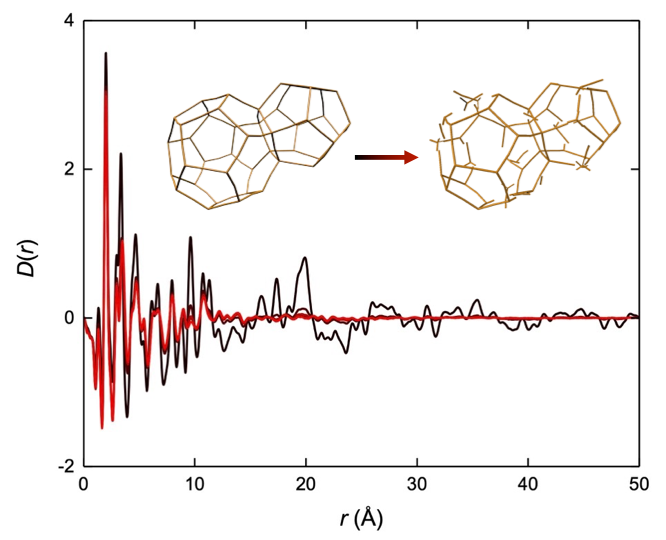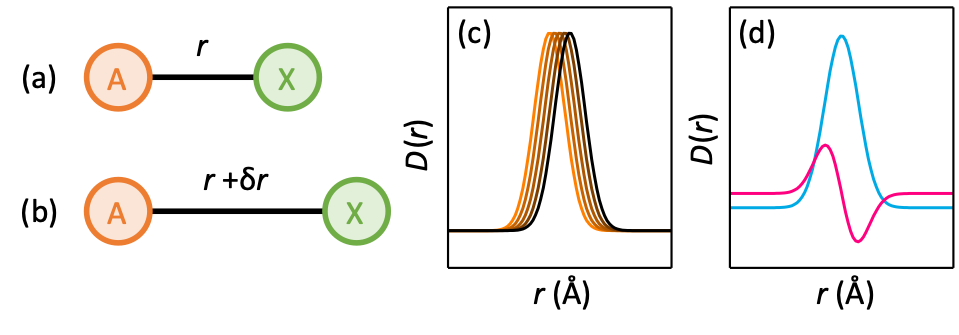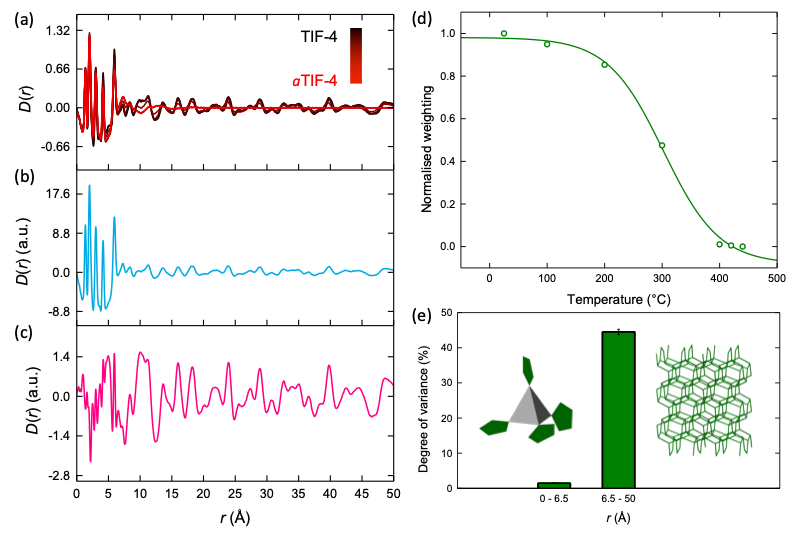
The human eye is excellent at pattern recognition. However, as modern experiments begin to generate increasingly complex data, even a well-trained eye requires some assistance. This idea of identifying patterns forms the foundation of our latest work, where we find that unique patterns hidden within X-ray scattering data possess powerful structural insight into so-called “disordering” processes.
Structural Disordering
Structural disorder is becoming an increasingly popular area of study within framework materials and can be introduced into a crystalline material by, for example, melting or ball milling. Understanding what is happening on the atomic scale as a material becomes disordered remains quite a challenge. The pair distribution function (PDF) is a local structure probe obtained from a relatively simple diffraction experiment and is very important for studying materials that have undergone a disordering process. However, it is not easy to describe or quantify the structural distortions occurring in these disordering processes. In our latest work, we have tackled this issue using a combination of PDF measurements and multivariate analysis.

Multivariate analysis aims to take a complex dataset and reduce it to its key components. This enables us to identify trends within the data more clearly. For example, the series of five PDFs in Figure 1 tracks the collapse of a crystalline metal–organic framework as we ball mill it. We can see that the PDFs share many similarities and many differences even at a glance. Two key questions then emerge – how can we go about describing these differences and what can this information tell us about the disordering process?
Concept of Distortion
Using a simple example, we first demonstrate how an increase in bond length (Figs. 2a and b) manifests in the PDFs (Fig. 2c) and how this leads to a unique feature (Fig. 2d) that is extracted using principal component analysis (a type of multivariate analysis). In essence, the unique signature we extract (the pink trace) is a direct fingerprint of the distortion that occurred in the atomic structure. We then extend this concept to study complex experimental datasets.

Ball-milling induced amorphisation
We first study MIL-100 and Fe-BTC, two compositionally identical metal–organic frameworks with crystalline and disordered structures, respectively. Through ball milling we introduce substantial structural disorder, rendering them both amorphous. We then collect PDF data following the amorphisation process. Our analysis allows us to characterise the nature of the distortion that occurs during ball milling and enables us to quantify the relative magnitudes of these distortions. Furthermore, we can perform our analysis over different subsections of the PDF to investigate how the behaviour varies over different length scales (Fig. 3). This reveals the local structure of the crystalline material is more sensitive to ball milling than its disordered counterpart.

Melting of a zeolitic imidazolate framework
Turning to a very different, both chemically and structurally, system of disorder we then illustrate the success of our approach in studying the melting of TIF-4. We begin with variable-temperature PDFs tracking the melting of TIF-4 to form the liquid aTIF‑4 (Fig. 4a). Again, we can see that the PDFs are similar but also with several differences that are hard to explicitly describe. Using principal component analysis, we extract two key components which allow us to identify patterns more easily (Figs. 4b & c). The first component looks much like the average of the dataset, if we were to squint at the dataset, we can see how the two are related. The second component, where much of our focus lies, describes how the original PDFs differ from the average component – this is a more complicated example of the distortion described in Figure 2d. The original dataset can be recovered by taking linear combinations of these two extracted components, the weightings of which provide us kinetic insight into the melting process (Fig. 4d). We find that the distortion’s weighting remains almost constant as the sample is heated until we begin to approach the melting temperature of around 400°C. Here, the structural distortion begins to act and augments the structure as we enter the liquid state. Furthermore, hierarchical analysis of the PDFs describes how the extent of the distortion in the local and extended structure of TIF-4 (Fig. 4e).

As disordered framework materials begin to gain traction as proton conductors, broadband dielectrics, and battery materials, the need to better understand their structure and formation is becoming increasingly vital. The work presented here represents a creative step forward in developing our understanding of atomic structure in disordered functional materials.
Given the generality of our approach, we envisage its application across a range of “disordering” studies such as MOFs under pressure, irradiation and melt-quenching. Some interesting future directions include (i) the interplay between our structural insights and physical properties, (ii) the use of distortion components in identifying disordering pheomena, and (iii) a more quantitative understanding of disorder in framework materials.
For more details, see our paper in Nature Communications: https://doi.org/10.1038/s41467-022-29849-6.
Twitter @adamsapnik
Follow the Topic
-
Nature Communications

An open access, multidisciplinary journal dedicated to publishing high-quality research in all areas of the biological, health, physical, chemical and Earth sciences.
Related Collections
With Collections, you can get published faster and increase your visibility.
Women's Health
Publishing Model: Hybrid
Deadline: Ongoing
Advances in neurodegenerative diseases
Publishing Model: Hybrid
Deadline: Dec 24, 2025


Please sign in or register for FREE
If you are a registered user on Research Communities by Springer Nature, please sign in